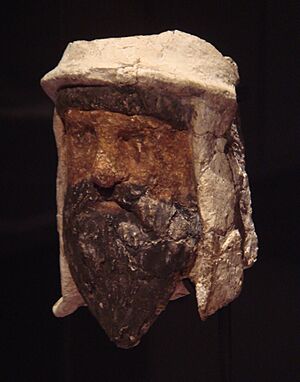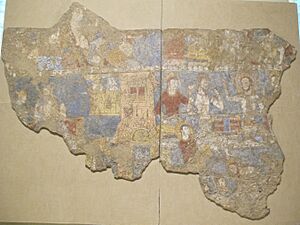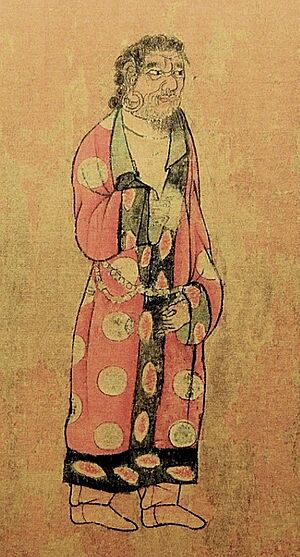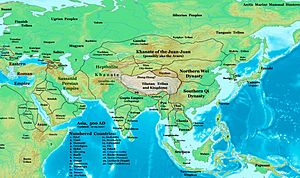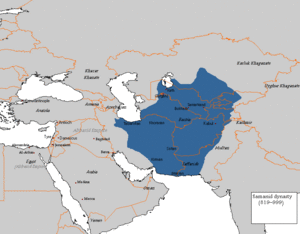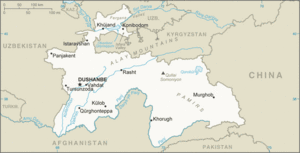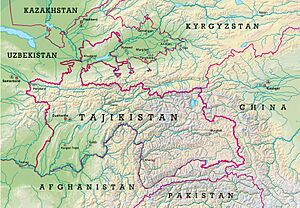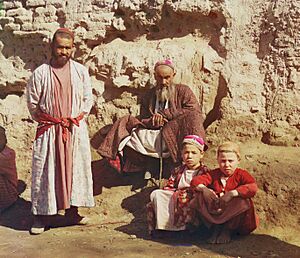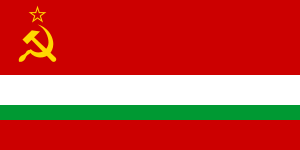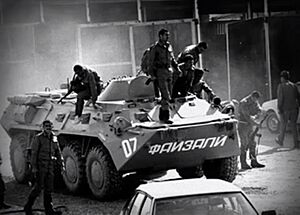History of Tajikistan facts for kids
The history of Tajikistan is very old, going back to the time of the Samanid Empire (819–999 AD). The Tajik people later came under Russian rule in the 1860s. After the Russian Revolution of 1917, a fight for freedom called the Basmachi revolt began. This revolt ended in the early 1920s during the Russian Civil War.
In 1924, Tajikistan became a special part of the Soviet Union, called the Tajik ASSR, within Uzbekistan. By 1929, it became its own republic, the Tajik Soviet Socialist Republic. Tajikistan stayed part of the Soviet Union until it became independent in 1991. This happened after the Soviet Union broke apart.
Since then, Tajikistan has had several changes in government. It also went through a difficult time called the Tajikistani Civil War. A peace agreement was signed in 1997 to end the fighting.
Contents
Ancient Times (600 BC – 710 AD)
In ancient times, Tajikistan was near the lands of the Scythians. The ancestors of today's Tajiks lived in four main areas. These were Sogdiana, Bactria, Merv, and Khorezm. Today, Tajiks mostly live in what was once Bactria and Sogdiana.
Bactria was located in northern Afghanistan and parts of southern Tajikistan. It was a very important place in the Bronze Age. Many believe that Zoroastrianism, an ancient religion, started here. The holy book of Zoroastrianism, the "Avesta," was written in an old Bactrian language.
Some historians also think that parts of modern Tajikistan were once part of Kambojas. This was an ancient kingdom mentioned in the Mahabharata epic.
Persian Rule (550 BC – 329 BC)
During the time of the Persian Empire, Sogdiana and Bactria were important regions. People from these areas held key roles in the Persian government and army.
Greek Influence (329 BC – 90 BC)
Alexander the Great defeated the Persian Empire. Then, he came to Bactria and Sogdiana. People there fought hard against him, led by a ruler named Spitamenes. Alexander married a local princess, Roxana, to help control the land.
After Alexander, Greek kingdoms ruled the area for about 200 years. This time is known as the Greco-Bactrian Kingdom. Later, a group called the Yuezhi took over. They helped create the Kushan Empire.
Kushan Empire (30 BC – 410 AD)
The Kushan Empire was a major power for 400 years. It was as strong as the Roman Empire and Han China. During this time, Buddhism spread from Central Asia to China. This was thanks to a famous Kushan king named Kanishka.
Later Empires (224–710 AD)
The Sassanids, a Persian empire, controlled much of Tajikistan. But they lost it to the Hephthalites. These Hephthalites created a strong empire. They even made Persia pay them tribute for a time.
Later, the Hephthalites were defeated by a mix of Sassanid and Kök-Turk forces. Tajikistan then came under the rule of the Kök-Turks. They eventually lost control to the Arabs in 710 AD.
Medieval History (710–1506)
Arab Caliphate (710–867)
The Arabs began raiding Central Asia in 651 AD. By 715 AD, they had taken control of the entire region. This brought the area under the rule of the Caliph and the religion of Islam. The Arabs often ruled through local kings.
The Abbasids took over the Caliphate in 750 AD. They built a large, strong state. This brought a new sense of unity to Central Asia, which it had not seen since Alexander the Great.
Samanid Empire (819–999)
The Samanid dynasty ruled a large area, including parts of modern Iran and Central Asia. They were one of the first local dynasties to rule Persia after the Arab conquest. Under Ismail Samani, the Samanids expanded their empire.
The cities of Bukhara (their capital) and Samarkand became centers of art, science, and learning. But after 950 AD, the Samanid power weakened. Turkic groups began to take over their lands. In 999 AD, the Qarakhanids took Bukhara, ending the Samanid dynasty.
Mongol Rule (1218–1370)
The Mongol Empire swept through Central Asia. They invaded the Khwarezmian Empire. Mongol armies looted and destroyed cities like Bukhara and Samarkand. They caused great destruction and loss of life.
Timurid Empire (1370–1506)
Timur, also known as Timur the Lame, founded the Timurid Empire. He was born near Samarkand in 1336. He was part of a Mongol tribe that had settled in the region.
Timur started as a bandit leader. His empire grew very large. Although his dynasty eventually fell in 1506, one of his descendants, Babur, later founded the Mughal Empire in India.
Early Modern History (1506–1868)
Turkic Rule (1506–1598)
After the Timurids, the Shaybanid state ruled the region. Their capital was first Samarkand, then Bukhara. This period of growth and wealth did not last long.
The Shaybanid dynasty ended and was replaced by the Janid dynasty. In 1709, the eastern part of the Khanate of Bukhara broke away. It formed the Khanate of Kokand. So, present-day Tajikistan was split between these two khanates.
Iranian and Bukharan Rule (1740–1868)
In 1740, the Janid khanate was conquered by Nader Shah, the ruler of Iran. The local khan became Nader's vassal. After Nader Shah died, the Manghit tribe took control of the Khanate of Bukhara. In 1785, it became the Emirate of Bukhara.
Modern History (1868–1991)
Russian Control (1868–1920)
In the late 1800s, the Russian Empire began to conquer Central Asia. Between 1864 and 1885, Russia took control of most of the region. This included parts of Tajikistan.
Russia wanted cotton for its factories. The American Civil War had stopped cotton supplies from the US. So, Russia looked to Central Asia for cotton and as a market for its goods. By 1885, Tajikistan was either ruled by Russia or its vassal state, the Emirate of Bukhara.
Russian forces faced strong resistance in some areas. But they defeated the army of the Emirate of Bukhara. The emir then became a vassal of Russia. He kept his throne with Russian help.
In the late 19th century, a movement called the Jadidists grew. They wanted to modernize Islamic society. Russia saw them as a threat. In 1916, there were protests in Khujand against forced military service during World War I.
In August 1920, Soviet troops overthrew the last emir. The Emirate of Bukhara was replaced by the Bukharan People's Soviet Republic.
Basmachi Movement (1916–1924)
The Basmachi movement was an uprising against Russian and Soviet rule. It started after the Russian Revolution of 1917. The movement began because Russia tried to draft Muslims into the army during World War I.
After the October 1917 Revolution, the Bolsheviks took power. Muslim groups in Central Asia tried to form their own government in Kokand. But the Bolsheviks attacked Kokand in February 1918. They killed many people. This made more people support the Basmachi movement.
The Basmachis fought a guerrilla war and controlled large parts of Central Asia. Their strength changed over time. But by 1923, the Red Army had largely defeated them. Resistance continued in some areas, especially against Soviet farming policies.
Soviet Rule (1920–1991)
In 1924, the Tajik Autonomous Soviet Socialist Republic was formed within Uzbekistan. But when new borders were drawn in 1928, important Tajik cities like Bukhara and Samarkand were placed in Uzbekistan. Many Tajiks were pressured to identify as "Uzbeks." Tajik schools were closed, and Tajiks faced discrimination.
Between 1927 and 1934, the Soviets forced farmers to join collective farms. This led to violence and forced moves for many peasants. Some even joined the Basmachi movement again. Some small industries also started, and irrigation systems were built.
The Soviet government also carried out purges, removing many people from the Communist Party of Tajikistan. Russians often replaced those who were removed. This meant Russians held most of the power. By 1959, Russians made up 13% of Tajikistan's population.
Tajiks began serving in the Soviet Army in 1939. During World War II, about 260,000 Tajik citizens fought. Between 60,000 and 120,000 Tajiks died in the war. After the war, efforts were made to improve farming and industry. But Tajikistan still lagged behind other Soviet republics.
By the 1980s, Tajikistan had the lowest savings and education rates in the Soviet Union. Living conditions were poor. When Mikhail Gorbachev introduced his "glasnost" (openness) policy, Tajiks could finally voice their complaints. In 1991, the Soviet Union collapsed, and Tajikistan became independent.
Republic of Tajikistan (1991–present)
Tajikistan was one of the last Soviet republics to declare independence. This happened on September 9, 1991. The use of the Tajik language became more popular. Russians, who had held many government jobs, lost influence. More Tajiks became involved in politics.
Soon after independence, the nation fell into a Tajikistani Civil War. Different groups fought each other, often based on family loyalties. Many non-Muslims, like Russians and Jews, left the country. They faced hardship and sought better opportunities elsewhere.
Emomali Rahmon became president in 1994 and still leads the country today. The civil war caused great devastation. Over 100,000 people died. About 1.2 million people became refugees. In 1997, a peace agreement was signed between Rahmon and the opposition.
Peaceful elections were held in 1999. Rahmon was re-elected with almost all the votes. Russian troops stayed in southern Tajikistan until 2005 to guard the border with Afghanistan. After the September 11 attacks in 2001, American, Indian, and French troops also came to the country.
In October 2020, President Emomali Rahmon was re-elected for another seven-year term. He won with 90 percent of the votes.
See also
 In Spanish: Historia de Tayikistán para niños
In Spanish: Historia de Tayikistán para niños
- Guzel Maitdinova
- Dissolution of the Soviet Union
- History of Central Asia
- Politics of Tajikistan
- Soviet Central Asia


